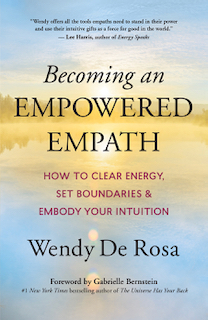
Strengthening Porous Boundaries
From the Inside Out
Juan Rodriguez Pazos/Getty
Personal boundaries are determined by childhood conditioning. Those with porous boundaries can shore them up by “reparenting” the lower chakras.
I have what psychologists call “porous boundaries.” Common characteristics of such boundaries describe me perfectly: fearing rejection when I don’t comply with other’s expectations, overexplaining and feeling bad when I say no, getting over-involved in other people’s problems, and a tendency toward oversharing. My porous boundaries extend emotionally and energetically as well—when I’m with someone who has an upset stomach, I often begin to feel sick too.
During the COVID lockdown, I largely enjoyed a break from uncomfortable situations, but now that socializing is coming back, my old challenges are resurfacing. Determined to use this reentry as an opportunity to reevaluate my life and transform stubbornly entrenched patterns that don’t support my wellbeing, I have embarked on a quest to build healthier boundaries.
Porous Boundaries, Core Wounds
Wendy De Rosa, founder of the School of Intuitive Studies and author of Becoming an Empowered Empath: How to Clear Energy, Set Boundaries & Embody Your Intuition, explains that the way we set personal boundaries is determined by childhood conditioning.
“If when we were young we learned to survive by prioritizing other people’s needs and emotions, we become disconnected from ourselves and [our] own feelings and desires,” she says. “Because this is what feels normal to us, the pattern keeps repeating. A lack of healthy boundaries is common for anyone raised in households with abuse, neglect, projected emotions, unclear boundaries, suppression of self, or lack of safety or belonging.”
[Read: “How Childhood Trauma Affects Adult Health.”]
And so, my porous boundaries aren’t just a random personality trait. Rather, they are a symptom of deeply embedded childhood wounds and instinctual fear-based adaptations.
I grew up with an emotionally volatile mother who’d endured a tremendous amount of trauma. Easily triggered, her outbursts felt like bombs going off—so destructive and terrifying that my number-one goal was to keep her calm and pacified. My fear and need for security had me perennially focusing all my attention on her emotional state at the expense of my own.
Reparenting Our Lower Chakras
De Rosa’s powerful approach to healing centers around the energetic body. “In school, we learn about the nervous system, the musculoskeletal system, the cardiovascular system, and more, but we never learn about energetic anatomy. Our energetic system, which includes our seven chakras, underlies our nervous system, so everything that we’re carrying on an energetic level impacts how we feel and respond to the world.”
Our three lower chakras, she explains, hold our personal needs for safety, trust, and identity, and they also carry our emotional wounds. Those of us with porous boundaries are often called to “reparent” our lower chakras by deeply listening to our most tender, vulnerable parts and honoring the needs and messages we receive.
“It’s our inner child that needs to gain emotional boundaries. She’s the one that gets to say, ‘No, I don’t want to do that,’ or ‘Yes I do!’ As we establish an uncompromisingly loving connection with ourselves, regardless of external circumstances or daily challenges, we begin to feel secure enough to reinhabit our energy body, which shifts us from being overly sensitive to empowered.”
De Rosa illuminates the importance of going back in time to unearth our core wounds and conditioned beliefs so that we can better identify the outdated, fear-based energy patterns that we continue to hold in our three lower chakras. “The protection mechanisms we developed in childhood were appropriate for that time in life when we were vulnerable. Now we have the capacity to reconnect with ourselves, feel our emotions, and take back our power so that we can have strong, clear boundaries, and no longer be a victim to the universe around us.”
Visualizing Healthy Boundaries
De Rosa’s book is rich with teachings about how to do this chakra healing work on our own. Before beginning, she asks us to ground our energy by visualizing a grounding cord in the form of a tree trunk hugging our hips and extending all the way down to the earth’s core where it sprouts roots. “Breathe deeply as you imagine Mother Earth holding you and offering total security. She is all-knowing and all-loving. There isn’t anything she can’t handle. She is mother to all and loves you unconditionally.”
As we feel securely held and connected, De Rosa has us shift our awareness to our first chakra—the root chakra which is ruby-red and located at our tailbone. “The root chakra is the earth element in our body. It holds information about our culture, physical body, and survival on this planet. The root chakra is much slower than the mind. It carries the power of safety, trust, belonging and innate love.”
De Rosa asks us to breathe deeply, inhaling safety and trust, while exhaling any conscious or subconscious fears about existing on this earth. “Let any fear contractions in your root chakra begin to unwind. Release that energy down and out of your grounding cord. In your mind or out loud, say: ‘I don’t need this energy anymore. I don’t need to hold what everybody else thinks and feels about me. I claim the power of safety and trust in my body.’ Let feelings of safety and trust expand as energy down your legs and into your feet. Feeling your grounding cord strong and secure, take a deep seat inside your body.”
Our second chakra is the sacral chakra—a vibrant orange power center in our pelvic region. This chakra relates to the rhythms of life, going with the flow, and the qualities of the divine feminine. “The foundation for power in the sacral chakra comes from trust in Self. Breathe deeply, relax, and allow yourself to receive your beautiful innate essence of playfulness and sweetness. Exhale and release any feelings of guilt, over-responsibility, shame, or suppressed emotions. Breathe through your feelings. Let your exhales be strong, and let your inhales bring nourishment and love to this area of your body.”
The third lower chakra—the solar plexus chakra—is a bright yellow like the sun. Focusing on this power center, De Rosa invites us to recognize any fears about how to survive in our culture or society. “This is the chakra of personal will, identity, and ego. It relates to both the digestion of food and the digestion of life. As we absorb and metabolize our life experiences, we integrate them into who we are, ultimately becoming the embodied essence of our experiences. It is from this center that we expand outward, manifest our true Self, radiate our power, and find our place within our family, community, and society.”
[Read: “Leaning Into the Back Side of Your Chakras.”]
De Rosa assures us that as we begin to listen to and nurture our inner child—while consciously clearing old, fear-based energy from our lower chakras as we welcome in Divine Source energy—we will begin to reconnect to the gut instincts that reside in our physical bodies. Soon, the unconscious ways we cross our own inner boundaries for others will become clear to us, our habitual patterns will begin to transform, and our boundaries will be less porous.
“Part of repairing our energetic boundaries is making a conscious choice not to abandon ourselves in our dynamics with others or the world,” she says. “Soon strong energetic boundaries become our new normal. Light radiates from inside of us, protecting and strengthening us. Our healthy boundaries come from this inner radiance.”
For more on porous boundaries, please enjoy Wendy De Rosa’s 7-minute Healthy Boundaries From the Inside Out guided visualization here and in the video below.











